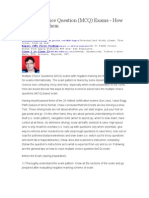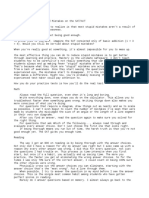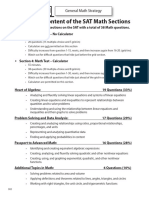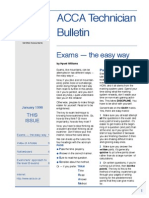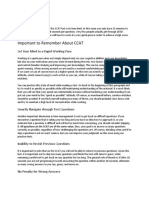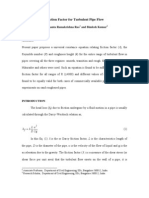General Strategies For Taking The SAT: 3trategy
General Strategies For Taking The SAT: 3trategy
Uploaded by
manja7585Copyright:
Available Formats
General Strategies For Taking The SAT: 3trategy
General Strategies For Taking The SAT: 3trategy
Uploaded by
manja7585Original Description:
Original Title
Copyright
Available Formats
Share this document
Did you find this document useful?
Is this content inappropriate?
Copyright:
Available Formats
General Strategies For Taking The SAT: 3trategy
General Strategies For Taking The SAT: 3trategy
Uploaded by
manja7585Copyright:
Available Formats
Strategy !
:
Dont rush into getting an answer without
thinking. Be careful if your answer comes
too easily, especially if the question is toward
the end of the section.
Beware of Choice A If You Get the Answer
Fast or Without Really Thinking
Everybody panics when they take an exam
like the SAT. And what happens is that they
rush into getting answers. Thats OK, except
that you have to think carefully. If a prob-
lem looks too easy, beware! And, especially
beware of the Choice A answer. Its usually a
lure choice for those who rush into getting
an answer without crit ically thinking about
it. Heres an example:
Did you subtract 7:07 from 8:08 and get
1 hour and 1 minute (61 minutes)? If you
did you probably chose Choice A: the lure
choice. Thinkdo you really believe that
the test maker would give you such an easy
question? The fact that you figured it out
so easily and saw that Choice A was your
answer should make you think twice. The
thing you have to realize is that there is
another possibility: 12:12 to 1:01 gives 49
minutes, and so Choice E is correct.
So, in summary, if you get the answer fast
and without doing much thinking, and its a
Choice A answer, think again. You may have
fallen for the Choice A lure.
Note: Choice A is often a lure choice
for those who quickly get an answer with-
out doing any real thinking. However, you
should certainly realize that Choice A
answers can occur, especially if there is no
lure choice.
Strategy 2:
Know and learn the directions to the ques-
tion types before you take the actual test.
Never Spend Time Reading Directions
During the Test or Doing Sample Questions
That Dont Count
All SATs are standardized. For example, all
the Regular Math questions have the same
directions from test to test as do the Math
General Strategies for Taking the SAT
Before studying the fourteen specific strategies for the Math questions p.(247), you will find
it useful to review the following five General Strategies for taking the Math SAT.
Below is a picture of a digital clock.
The clock shows that the time is 6:06.
Consider all the times on the clock where
the hour digit is the same as the minute
digit like in the clock shown below.
Another such double time would be
8:08 or 9:09. What is the smallest time
period between any two such doubles?
(A) 61 minutes
(B) 60 minutes
(C) 58 minutes
6 : 06
(D) 50 minutes
(E) 49 minutes
24S - GPLB!P'S COMP!!T! SAT MATH WOPKBOOK
Grid-In questions. So its a good idea to
learn these sets of directions and familiar-
ize yourself with their types of questions
early in the game before you take your
actual SAT.
For an example of a set of Grid-In type
directions see p. 249.
If on your actual test you spend time
reading these directions and/or answering
the sample question, you will waste valuable
time.
Strategy 3:
It may be wiser not to leave an answer
blank.
The Penalty for Guessing Is Much Smaller
Than You Might Expect
On the SAT you lose a percentage of
points if you guess and get the wrong
answer. Of course, you should always try
to eliminate choices. Youll find that, after
going through this book, youll have a
better chance of eliminating wrong answers,
However, if you cannot eliminate any
choice in a question and have no idea of
how to arrive at an answer, you might want
to pick any answer and go on to the next
question.
There are two reasons for this:
1. You dont want to risk mismarking a
future answer by leaving a previous
answer blank.
2. Even though there is a penalty for guess-
ing, the pen alty is much smaller than you
might expect, and this way you have at
least a chance of getting the question
right. Suppose, for example, that you
have a five-choice question:
From a probabilistic point of view, it is very
likely that you would get one choice right
and four wrong (you have a 1 in 5 chance of
getting a five-choice question right) if you
randomly guess at the answers. Since
1
4
point is taken off for each wrong five-choice
question, youve gotten 1
1
4
4 0
points, because youve gotten 1 ques-
tion right and 4 wrong. Thus you break
even. So the moral is whether you
randomly guess at questions youre not
sure of at all or whether you leave those
question answers blank; it doesnt make a
difference in the long run!
Strategy 4:
Write as much as you want in your test
booklet.
Test Booklets Arent GradedSo Use Them
As You Would Scrap Paper
Many students are afraid to mark up their
test book lets. But, the booklets are not
graded! Make any marks you want. In fact,
some of the strategies demand that you
extend or draw lines in geometry ques-
tions or label diagrams, or circle incorrect
answers, etc. Thats why when I see com-
puter programs that show only the ques-
tions on a screen and prevent the student
from marking a diagram or circling an
answer, I realize that such programs pre-
vent the student from using many powerful
strategies. So write all you want on your test
bookletuse your test paper as you would
scrap paper.
Strategy 5:
Use your own coding system to tell you
which questions to return to.
If You Have Extra Time after Completing a Test
Section, Youll Know Exactly Which Questions
Need More Attention
When you are sure that you have
answered a question correctly, mark your
question paper with . For questions you
are not sure of but for which you have
eliminated some of the choices, use ?.
For questions that youre not sure of at
all or for which you have not been able
to eliminate any choices, use ??. This will
give you a birds-eye view of what ques-
tions you should return to, if you have
time left after completing a particular
test section.
COMP!!T! T!M!-SAV!^G STPAT!G!!S A^D SHOPTCLTS - 249
You might also like
- New York City SHSAT Prep 2022 & 2023: 3 Practice Tests + Proven Strategies + ReviewFrom EverandNew York City SHSAT Prep 2022 & 2023: 3 Practice Tests + Proven Strategies + ReviewNo ratings yet
- UCAT Study Guide PDFDocument10 pagesUCAT Study Guide PDFMajor dumbassNo ratings yet
- Tips, Strategies For Numerical Tests, Psychometric, Aptitude TestsDocument11 pagesTips, Strategies For Numerical Tests, Psychometric, Aptitude Testscorporateboy36596100% (3)
- ACT Reading StrategiesDocument24 pagesACT Reading StrategiesSara Beth AlexanderNo ratings yet
- Ccat Study Guide PDFDocument12 pagesCcat Study Guide PDFdipika100% (1)
- ACT Math & Science Prep: Includes 500+ Practice QuestionsFrom EverandACT Math & Science Prep: Includes 500+ Practice QuestionsRating: 3 out of 5 stars3/5 (1)
- What Is A Problem?: Method + Answer SolutionDocument17 pagesWhat Is A Problem?: Method + Answer SolutionShailaMae VillegasNo ratings yet
- The 10 Most Common SAT Math MistakesDocument7 pagesThe 10 Most Common SAT Math MistakesSean GonzalesNo ratings yet
- MCQ TipsDocument42 pagesMCQ TipsdpkkrsterNo ratings yet
- Approaching ExamsDocument16 pagesApproaching Examscolin robertsNo ratings yet
- A Guide To Testing Smart On Multiple Choice Exams: As Time Goes byDocument8 pagesA Guide To Testing Smart On Multiple Choice Exams: As Time Goes byVivek ShuklaNo ratings yet
- Exam Tips - Exam Success Factors Tips For Taking CPIM ExamsDocument2 pagesExam Tips - Exam Success Factors Tips For Taking CPIM ExamsAbhijit NerurkarNo ratings yet
- AMC 8 InstructionsDocument3 pagesAMC 8 InstructionsngocnguyenwaNo ratings yet
- SAT Traps: Math Traps: The Right Wrong AnswersDocument6 pagesSAT Traps: Math Traps: The Right Wrong AnswersGiorgi KvantrishviliNo ratings yet
- What Is It?: Process of EliminationDocument4 pagesWhat Is It?: Process of EliminationNeil YangNo ratings yet
- Exam Test Taking Strategies: Page 1Document4 pagesExam Test Taking Strategies: Page 1Ravi-ANo ratings yet
- How To Succeed in Math CompetitionsDocument3 pagesHow To Succeed in Math CompetitionsxSubrillaNo ratings yet
- Yellow Test BatteryDocument14 pagesYellow Test Batterysushanta21100% (1)
- 10 LSAT Test Taking Tips and Strategies 10 MINUTESDocument2 pages10 LSAT Test Taking Tips and Strategies 10 MINUTESbavonenaneNo ratings yet
- McKinsey PST Coaching GuideDocument0 pagesMcKinsey PST Coaching GuideMiguelGoncalves75% (4)
- LSAT Exam Prep - Logical ReasoningDocument28 pagesLSAT Exam Prep - Logical ReasoningsejinmaNo ratings yet
- SAT StrategyDocument29 pagesSAT StrategyThanh Tùng MaiNo ratings yet
- Multiple Choice Question (MCQ) Exams - How To Crack Them: Grockit GMAT Prep Alpari (UK) Forex Trading Class 1 To Class 12Document16 pagesMultiple Choice Question (MCQ) Exams - How To Crack Them: Grockit GMAT Prep Alpari (UK) Forex Trading Class 1 To Class 12rajeev69No ratings yet
- SAT TipsDocument24 pagesSAT TipsSeve ReyesNo ratings yet
- SAT Tips and TricksDocument7 pagesSAT Tips and Tricksadewaleajani20No ratings yet
- 5 Easy Ways To Improve Your Exam PerformanceDocument6 pages5 Easy Ways To Improve Your Exam PerformanceFrancis Ho HoNo ratings yet
- College Panda Sat AdviceDocument4 pagesCollege Panda Sat AdvicedddNo ratings yet
- General StrategyDocument9 pagesGeneral StrategySaraf santhosh kumarNo ratings yet
- AshjnokDocument4 pagesAshjnokAjiteshNo ratings yet
- (Template) 9702 Student Learner Guide (Paper Specific Checklist)Document9 pages(Template) 9702 Student Learner Guide (Paper Specific Checklist)shahzodbekaliyev07No ratings yet
- English Essay Wrting Guide For Hots QuestionsDocument29 pagesEnglish Essay Wrting Guide For Hots QuestionsfeliciayongshooklooiNo ratings yet
- ACCA Technician Bulletin: Exams - The Easy WayDocument2 pagesACCA Technician Bulletin: Exams - The Easy WayjabbarjiveNo ratings yet
- What Is The SAT?Document4 pagesWhat Is The SAT?Hari Nath ReddyNo ratings yet
- MCQ PatternDocument14 pagesMCQ Patternavm130% (1)
- Examinations: Before The ExamDocument6 pagesExaminations: Before The ExamShirley YipNo ratings yet
- Article On MathsDocument2 pagesArticle On Mathszoya khanNo ratings yet
- Session 46 Vanden Heuvel 1Document15 pagesSession 46 Vanden Heuvel 1zohreNo ratings yet
- Act Tips & Tricks: 1. DO Keep Calm and Carry OnDocument10 pagesAct Tips & Tricks: 1. DO Keep Calm and Carry OnFrodoNo ratings yet
- 10 Tips On Passing The LET ExamDocument3 pages10 Tips On Passing The LET ExamMarkGenesisCabreraNo ratings yet
- NHSPE ReadingDocument5 pagesNHSPE ReadingMohamed HanafiNo ratings yet
- CMA Exam Tips Prepared by HOCK International: Multiple-Choice Question TipsDocument2 pagesCMA Exam Tips Prepared by HOCK International: Multiple-Choice Question TipsMallikarjun MishraNo ratings yet
- AIEEE Tips & TricksDocument8 pagesAIEEE Tips & TricksDivyanshi SharmaNo ratings yet
- Blue Test BatteryDocument17 pagesBlue Test BatteryAndresSalasNo ratings yet
- How To Pass Numerical Reasoning TestsDocument3 pagesHow To Pass Numerical Reasoning Testsdhdj sjghNo ratings yet
- Tips On Taking Multiple Choice Exams NEWDocument2 pagesTips On Taking Multiple Choice Exams NEWTemp TempNo ratings yet
- Joyce 49 Proven NCLEX StrategiesDocument34 pagesJoyce 49 Proven NCLEX StrategiesHatem FaroukNo ratings yet
- Chapter #5 QuestionsDocument2 pagesChapter #5 QuestionsKaylin ObrochtaNo ratings yet
- Tips Gate 2012Document2 pagesTips Gate 2012rockymenaNo ratings yet
- How To Tackle Math Olympiad QuestionsDocument8 pagesHow To Tackle Math Olympiad QuestionsKaushal KumarNo ratings yet
- Attachment PDFDocument13 pagesAttachment PDFEmmanuel HaggaiNo ratings yet
- Tips For Scoring Good Marks in JNTU Final ExamsDocument7 pagesTips For Scoring Good Marks in JNTU Final Examschaitanya303No ratings yet
- Test-Taking Strategies: Preparing For Tests Taking Tests Reducing Test AnxietyDocument13 pagesTest-Taking Strategies: Preparing For Tests Taking Tests Reducing Test Anxietymus1402No ratings yet
- Exam StrategiesDocument2 pagesExam StrategiesMuhammad FadzilNo ratings yet
- Section A TipsDocument10 pagesSection A TipsNoor IrinaNo ratings yet
- Rules of The Free ResponseDocument3 pagesRules of The Free Responseapi-234419767No ratings yet
- 11 Tips On How To Answer Board Exam QuestonsDocument6 pages11 Tips On How To Answer Board Exam QuestonsmarkNo ratings yet
- CW GAT - Preparation and TipsDocument4 pagesCW GAT - Preparation and TipsHassnain AbbasNo ratings yet
- CC at Study GuideDocument8 pagesCC at Study GuideTa LaNo ratings yet
- Boot Camp for Your Brain: A No-Nonsense Guide to the Sat Fifth EditionFrom EverandBoot Camp for Your Brain: A No-Nonsense Guide to the Sat Fifth EditionNo ratings yet
- Printhandler AshxDocument17 pagesPrinthandler AshxALINA LAMICHHANENo ratings yet
- Understanding HeatDocument2 pagesUnderstanding HeatachellezgoNo ratings yet
- Makaut 6th Semester SyllabusDocument22 pagesMakaut 6th Semester Syllabusthesatyajeet.tmsl100% (1)
- 750 Ss Parts 2002Document108 pages750 Ss Parts 2002LouisNo ratings yet
- 6 Tuesday World of Self, Family and FriendsDocument4 pages6 Tuesday World of Self, Family and Friendshimeza96No ratings yet
- Bandura's Observational LearningDocument11 pagesBandura's Observational Learninghershey ysulatNo ratings yet
- Haier Case BADM 449Document2 pagesHaier Case BADM 449Nhi NguyễnNo ratings yet
- Organ of CortiDocument6 pagesOrgan of CortiNTA UGC-NETNo ratings yet
- Friction Factor For Turbulent Pipe FlowDocument16 pagesFriction Factor For Turbulent Pipe Flowyu won hoNo ratings yet
- Chapter 9Document7 pagesChapter 9Saharin Islam ShakibNo ratings yet
- LESSON NO. 2 (3 Hours) Title: Understanding Sources: What Is A SourceDocument6 pagesLESSON NO. 2 (3 Hours) Title: Understanding Sources: What Is A SourceJeya Plays YTNo ratings yet
- Purple Comet 2017 - Middle SchoolDocument2 pagesPurple Comet 2017 - Middle Schoolmichelle tanNo ratings yet
- Mahesh Geegal GMC SuratDocument3 pagesMahesh Geegal GMC SuratPNo ratings yet
- Carbonation of Concrete PDFDocument20 pagesCarbonation of Concrete PDFDebolina Das100% (1)
- Project Format BBIDocument7 pagesProject Format BBISainaNo ratings yet
- 112 PDFDocument14 pages112 PDFAnonymous BkmsKXzwyKNo ratings yet
- Investigating The Macro Perspective Affecting The Passing Rate in Board Examinations: A Take-Off Point in Designing A Causal ModelDocument13 pagesInvestigating The Macro Perspective Affecting The Passing Rate in Board Examinations: A Take-Off Point in Designing A Causal ModelNeil Owen RaNo ratings yet
- Cell Selection/reselection: Graham Whyley - Technical Master TrainerDocument50 pagesCell Selection/reselection: Graham Whyley - Technical Master TrainerWaheed Ali100% (1)
- M11 MishkinEakins3427056 08 FMI C11Document53 pagesM11 MishkinEakins3427056 08 FMI C11habiba ahmedNo ratings yet
- Sustainability 15 06896Document25 pagesSustainability 15 06896Ananda Locky SetyawanNo ratings yet
- Hard Sudoku 2Document10 pagesHard Sudoku 2recie lamboNo ratings yet
- Compare and Contrast Process in Plants and Animals GasDocument2 pagesCompare and Contrast Process in Plants and Animals GasJohn Dela CruzNo ratings yet
- OHSA Portable Ladder Safety GuideDocument24 pagesOHSA Portable Ladder Safety GuideRauf Huseynov100% (3)
- Bird Migration: By:Pratima Behera Roll - No:31916028Document9 pagesBird Migration: By:Pratima Behera Roll - No:31916028KrishnaNo ratings yet
- Special SensesDocument4 pagesSpecial SensesGrayson JamesNo ratings yet
- Absorption and Emission: Each: Description/Concepts Principle Instrumentation Information Provided ApplicationDocument3 pagesAbsorption and Emission: Each: Description/Concepts Principle Instrumentation Information Provided ApplicationREIGNE KRISTY CA�ADANo ratings yet
- Cisco Hyperflex Systems: Hyperconverged Multicloud PlatformDocument4 pagesCisco Hyperflex Systems: Hyperconverged Multicloud PlatformRakesh KumarNo ratings yet
- Chapter 3 Introduction To Data Science A Python Approach To Concepts, Techniques and ApplicationsDocument22 pagesChapter 3 Introduction To Data Science A Python Approach To Concepts, Techniques and ApplicationsChuin-Shan David ChenNo ratings yet
- The Latest Thinking? Time To Out-Think It.: Graduate and Undergraduate OpportunitiesDocument21 pagesThe Latest Thinking? Time To Out-Think It.: Graduate and Undergraduate OpportunitiesalzndlNo ratings yet






















